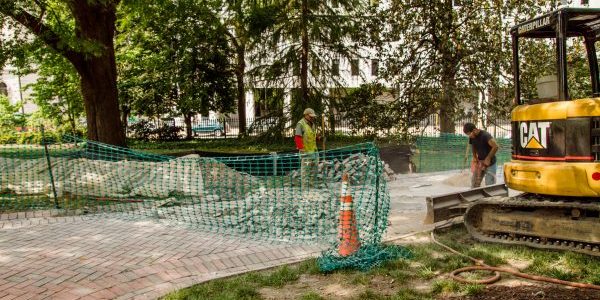The new Chesapeake Bay Landscape Professional Certification Program is working to educate landscape professionals on conservation landscaping, stormwater management, and how to maintain projects for long-term success. Level 1 participants are asked to utilize a variety of different study materials and attend an in-person practicum before taking the certification test. One of the study materials is the newly developed, “CBLP Sustainable Landscapes Maintenance Manual” written by Cheryl Corson. This manual provides a condensed review of the most important landscape maintenance considerations. Cheryl was recently interviewed about her experience and the need for this manual.
Cheryl Corson, RLA, ASLA, is a landscape architect and writer in private practice in the greater D.C. metro area. She also instructs landscape architecture licensure candidates in preparing for the design, stormwater management, and construction sections of the LARE exam. Cheryl holds a bachelor’s degree in Public Administration, and received her master’s degree in Landscape Architecture from the Harvard Graduate School of Design.
Q: Can you provide some detail on your background? How did you end up in this work?
In my private practice I incorporate stormwater management practices in virtually every project. One example is the demonstration rain garden I designed for the new carousel area at the Smithsonian National Zoo, installed in 2014. Funded by the DD Department of Energy and Environment, this project cleans and detains water headed into Rock Creek, just downstream. Interpretive signage at the site encourages people to install rain gardens on their own properties.
Q: Why was a maintenance manual needed?
Some government agencies, like the D.C. Department of Energy & Environment, require maintenance plans as part of their stormwater managmenent requirements, such as DC’s Green Area Ratio (GAR) program. Although DC offers some maintenance guidance in its 2013 Stormwater Manual, it is difficult for contractors and designers to easily find and reference it. With all the stormwater management compliance activities occurring within the Chesapeake Bay Watershed, public officials are well aware that maintenance is the weakest link in enduring water treatment solutions. There are many manuals out there, though most are brief, and usually limited to BMP maintenance. This Manual covers the entire landscape maintenance context, including documentation, concise BMP evaluation forms, and other important landscape types which may contain sustainable practices such as historic properties and nature play spaces.
Q: How did you come up with the idea to develop a manual?
Two years ago, a private design client, a new townhome development near DC’s baseball stadium on the Anacostia River, wanted to put their maintenance contract out to bid with my help. The development was certified as LEED Silver, so it seemed logical to include “green” landscape specifications in the RFP. I was quite surprised to learn that no such specifications were available, and felt the need to try and rectify that situation. When DC’s DOEE and the emerging Chesapeake Bay Landscape Professional program turned out to have a similar need, the project came together rather quickly.
Q: How will this information be used by the certified landscape professionals?
Newly certified landscape professionals will hopefully use the information in the Manual to craft LMPs, (landscape maintenance plans) for their clients, using the most sustainable practices. They will be able to inform their clients about what these practices are, and gradually help make these a requested, and hopefully expected standard of care for all types of landscapes.
Q: Who else might find this manual helpful?
Hopefully, government agencies will also use this Manual to guide their Public Works departments and landscape maintenance staff in Parks & Recreation departments, Transportation departments, and School facilities staff responsible for landscape maintenance. It is also hoped that even when this work is not performed in house, it will become a reference specification for such work when contracted out by public agencies. An agency could put out an RFP, for example, stating that, “work shall be performed in accordance with the manual, “Sustainable Landscape Maintenance for the Chesapeake Bay Watershed.”
Q: Will it be distributed outside the certification program?
The Manual is a free pdf download to anyone interested in using it due to the public funding it received from the DC Department of Energy and Environment and the Low Impact Development Center.
Q: What are some of the biggest challenges you think landscape professionals face working in conservation? Opportunities?
The biggest challenge is also the biggest opportunity, which is the great need for skilled labor in maintaining the new American landscape in an ecologically and aesthetically responsible fashion. We have learned a great deal in the past ten to fifteen years about how to sustainably clean and retain stormwater on site, and how to design and build landscapes supportive to pollinators and other wildlife. Workforce development and client education will help sustain these goals. If this Manual is useful in creating a more informed workforce and a client base aware of the sustained benefits of such landscapes, it will have played a valuable role.




this is very good interview… nice topic
Nice conversation with Cheryl Corson!
It’s really good that every homeowner takes initiative in maintaining the wellness of their home. It will not only beautify it but also increase the property’s value.
Nice flow of interview! Keep it up.
Cheryl knows! What a great example of someone who is thorough and experienced in their craft.